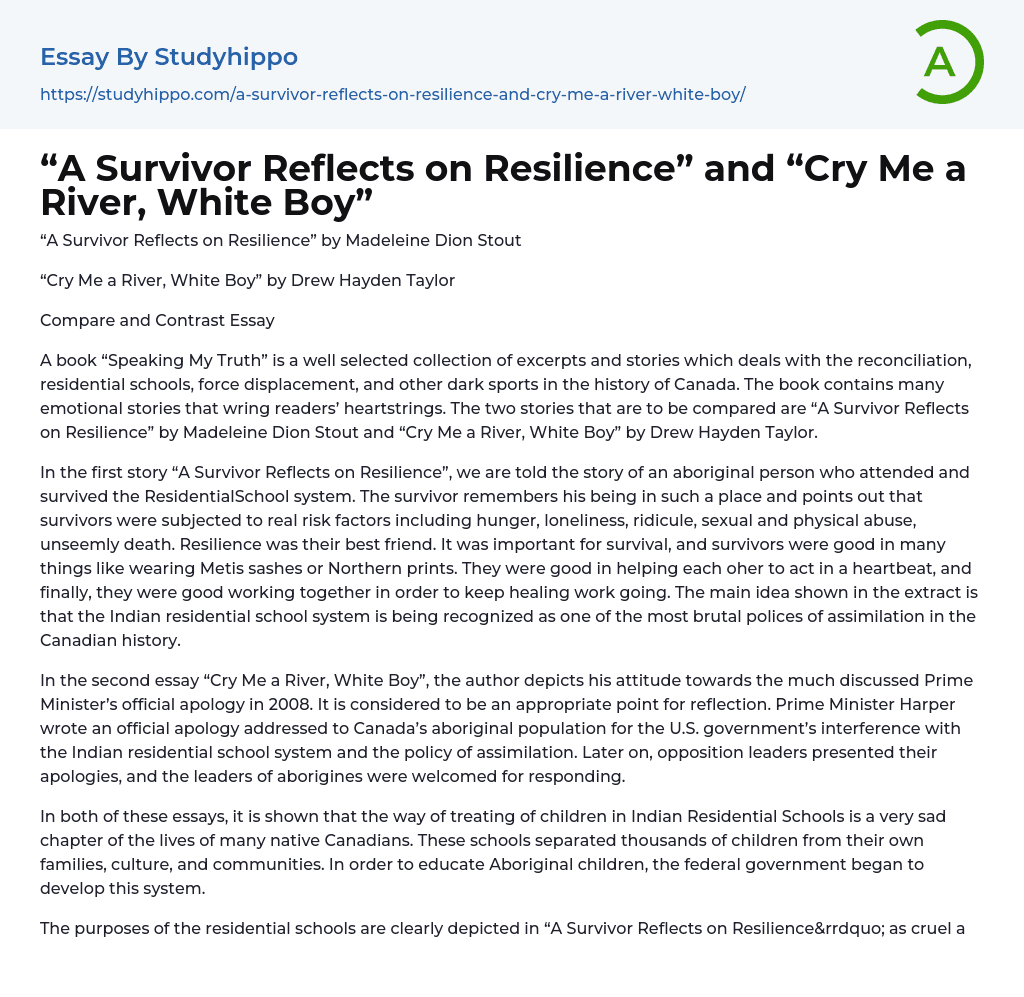

“A Survivor Reflects on Resilience” and “Cry Me a River, White Boy” Essay Example
“A Survivor Reflects on Resilience” by Madeleine Dion Stout
“Cry Me a River, White Boy” by Drew Hayden Taylor
Compare and Contrast Essay
A book “Speaking My Truth” is a well selected collection of excerpts and stories which deals with the reconciliation, residential schools, force displacement, and other dark sports in the history of Canada. The book contains many emotional stories that wring readers’ heartstrings. The two stories that are to be compared are “A Survivor Reflects on Resilience” by Madeleine Dion Stout and “Cry Me a River, White Boy” by Drew Hayden Taylor.
In the first story “A Survivor Reflects on Resilience”, we are told the story of an aboriginal person who attended and survived the ResidentialSchool system. The survivor remembers his being in such a place and points out that survivors were subjecte
...d to real risk factors including hunger, loneliness, ridicule, sexual and physical abuse, unseemly death. Resilience was their best friend. It was important for survival, and survivors were good in many things like wearing Metis sashes or Northern prints. They were good in helping each oher to act in a heartbeat, and finally, they were good working together in order to keep healing work going. The main idea shown in the extract is that the Indian residential school system is being recognized as one of the most brutal polices of assimilation in the Canadian history.
In the second essay “Cry Me a River, White Boy”, the author depicts his attitude towards the much discussed Prime Minister’s official apology in 2008. It is considered to be an appropriate point for reflection. Prime Minister Harper wrote an official apology addressed to Canada’s aborigina
population for the U.S. government’s interference with the Indian residential school system and the policy of assimilation. Later on, opposition leaders presented their apologies, and the leaders of aborigines were welcomed for responding.
In both of these essays, it is shown that the way of treating of children in Indian Residential Schools is a very sad chapter of the lives of many native Canadians. These schools separated thousands of children from their own families, culture, and communities. In order to educate Aboriginal children, the federal government began to develop this system.
The purposes of the residential schools are clearly depicted in “A Survivor Reflects on Resilience&rrdquo; as cruel and unjust. The main purposes of their existence were to limit and isolate the influence of the native culture on children as well as assimilate them creating a single dominant culture. At that time, these objectives grounded on the fact that Aboriginal cultures were unequal sounded in the following words “Kill the Indian in the child”. Fortunately, nowadays, everyone understands that this assimilation policy was not right and caused a lot of harm.
In “Cry Me a River, White Boy”, the author calls the apology an event, which closed the sad page of the Canadian history. In his speech, the Prime Minster tells that now the government recognizes that the consequences of the residential schools system were negative and had a damaging influence on both Aboriginal culture and language. Of course, there were some students who spoke positively about their experience at residential schools, but there were much more of those who endured it without pleasure. These two stories are overshadowed by horrible accounts of the physical, emotional, as
well as sexual abuse and children’s separation from beloved families and native communities. Now, the main task of the government is to support The Aboriginal Healing Foundation in that passionate way they supported the idea of the Indian residential school system many years ago.
- Feminism essays
- Animal Rights essays
- Animal Testing essays
- Bullying essays
- Abortion essays
- Abuse essays
- Immigration essays
- Poverty essays
- Human Rights essays
- Inequality essays
- Violence essays
- Torture essays
- Crash essays
- Assault essays
- Racism essays
- Prejudice essays
- Controversial Issue essays
- Cyber Bullying essays
- Women's Suffrage essays
- Women'S Rights essays
- Women Empowerment essays
- Sojourner Truth essays
- Bullying In Schools essays
- Pro Choice essays
- Pro Life essays
- Should Abortion Be Legal essays
- Against abortion essays
- Abortion Debate essays
- Abuse Support essays
- Child Abuse essays
- Alcohol Abuse essays
- Physical Abuse essays
- Sexual Abuse essays
- Substance Abuse essays
- Migration essays
- Human Migration essays
- Illegal Immigration essays
- Immigrants essays
- Refugee essays
- Overpopulation essays
- Homelessness essays
- Hunger essays
- Dumpster Diving essays
- Homelessness In America essays
- Euthanasia essays
- Assisted Suicide essays
- Censorship essays
- Gun Control essays
- Empowerment essays
- Civil Rights essays



